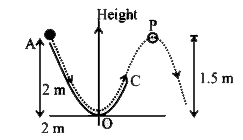The tendency to form pπ−pπ multiple bonds in group 14 is
most prominent for
C
Si
Sn
Pb
The correct Answer is:A
To solve the question regarding the tendency to form pπ−pπ multiple bonds in group 14 elements, we can follow these steps:
Step 1: Understand the Group 14 Elements
Group 14 of the periodic table consists of elements such as Carbon (C), Silicon (Si), Germanium (Ge), Tin (Sn), and Lead (Pb).
Step 2: Identify the Concept of pπ−pπ Bonding
The pπ−pπ bonding refers to the overlap of p-orbitals from adjacent atoms to form multiple bonds (like double or triple bonds). This type of bonding is crucial in determining the reactivity and bonding characteristics of the elements.
Step 3: Analyze the Trend in Group 14
As we move down the group from Carbon to Lead:
- The size of the atoms increases.
- The effectiveness of pπ−pπ bonding decreases due to the larger atomic size and increased distance between the p-orbitals.
- Additionally, larger atoms experience more repulsion between the electrons in the p-orbitals, which further reduces the tendency to form multiple bonds.
Step 4: Compare the Elements
- Carbon: Being the smallest element in the group, it has the highest tendency to form pπ−pπ multiple bonds with other elements (like nitrogen and oxygen).
- Silicon: Although it can form some multiple bonds, its larger size and the associated factors reduce this tendency significantly.
- Germanium, Tin, and Lead: These elements have even larger atomic sizes, making pπ−pπ bonding even less favorable.
Step 5: Conclusion
From the analysis, we conclude that the tendency to form pπ−pπ multiple bonds is most prominent for Carbon in Group 14.
Final Answer
The tendency to form pπ−pπ multiple bonds in group 14 is most prominent for Carbon (C).
---
Group 14 of the periodic table consists of elements such as Carbon (C), Silicon (Si), Germanium (Ge), Tin (Sn), and Lead (Pb).
The pπ−pπ bonding refers to the overlap of p-orbitals from adjacent atoms to form multiple bonds (like double or triple bonds). This type of bonding is crucial in determining the reactivity and bonding characteristics of the elements.
As we move down the group from Carbon to Lead:
- The size of the atoms increases.
- The effectiveness of pπ−pπ bonding decreases due to the larger atomic size and increased distance between the p-orbitals.
- Additionally, larger atoms experience more repulsion between the electrons in the p-orbitals, which further reduces the tendency to form multiple bonds.
- Carbon: Being the smallest element in the group, it has the highest tendency to form pπ−pπ multiple bonds with other elements (like nitrogen and oxygen).
- Silicon: Although it can form some multiple bonds, its larger size and the associated factors reduce this tendency significantly.
- Germanium, Tin, and Lead: These elements have even larger atomic sizes, making pπ−pπ bonding even less favorable.
From the analysis, we conclude that the tendency to form pπ−pπ multiple bonds is most prominent for Carbon in Group 14.
The tendency to form pπ−pπ multiple bonds in group 14 is most prominent for Carbon (C).
Topper's Solved these Questions
- BOOK - ICSECHAPTER - SOME P-BLOCK ELEMENTS EXERCISE - TRUE OR FALSE TYPE QUESTION19videos
SOME P-BLOCK ELEMENTS
- BOOK - ICSECHAPTER - SOME P-BLOCK ELEMENTS EXERCISE - FILL IN THE BLANKS TYPE QUESTIONS22videos
SOME P-BLOCK ELEMENTS
- BOOK - ICSECHAPTER - SOME P-BLOCK ELEMENTS EXERCISE - ESSAY (LONG ANSWER) TYPE QUESTION36videos
SOME P-BLOCK ELEMENTS
- BOOK - ICSECHAPTER - SOME BASIC CONCEPTS OF CHEMISTRY EXERCISE - NCERT TEXT-BOOK EXERCISES (WITH HINGS AND SOLUTIONS)36videos
SOME BASIC CONCEPTS OF CHEMISTRY
- BOOK - ICSECHAPTER - STATES OF MATTER : GASES AND LIQUIDSEXERCISE - NCERT TEXT-BOOK EXERCISES (With Hints and Solutions)23videos
STATES OF MATTER : GASES AND LIQUIDS
Similar Questions
Knowledge Check
- Question 1 - Select One
dπ−pπ bonding exists in
AdiamondBgraphiteCtrisilylamineDnone of these
The element that shows greater ability to form pπ−pπ multiple bonds is :
View SolutionThe tendency to form halide hydrates in group 2 elements ?
View SolutionA particle (m = 3 kg) slides down a frictionless track (AOC) starting from rest at a point A (height 2m). After reaching C, the particle continues to move freely in air as a projectile. When it reaching its highest point P (height 1.5 m) the kinetic energy of the prarticle (in J) is : Figure drawn is schematic and not to scale , take g = 10ms−2
 View Solution
View SolutionThe group 15 element having maximum tendency to form multiple bond is ___ .
View SolutionWhich of the following elements form pπ−dπ bonding in its oxide ?
View Solutiondπ=pπ bond present in:
View Solutionπ bond is formed by
View Solution

